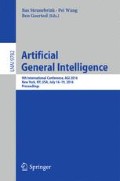Abstract
This paper proposes a way of bridging the gap between symbolic and sub-symbolic reasoning. More precisely, it describes a developing system with bounded rationality that bases its decisions on sub-symbolic as well as symbolic reasoning. The system has a fixed set of needs and its sole goal is to stay alive as long as possible by satisfying those needs. It operates without pre-programmed knowledge of any kind. The learning mechanism consists of several meta-rules that govern the development of its network-based memory structure. The decision making mechanism operates under time constraints and combines symbolic reasoning, aimed at compressing information, with sub-symbolic reasoning, aimed at planning.
Access this chapter
Tax calculation will be finalised at checkout
Purchases are for personal use only
References
Anderson, J., Bothell, D., Byrne, M., Douglass, S., Lebiere, C., Qin, Y.: An integrated theory of the mind. Psychol. Rev. 111(4), 1036 (2004)
Fitzpatrick, R., Heiberg, J.: Euclid’s Elements (2007)
Goertzel, B., Pennachin, C., Geisweiller, N.: The OpenCog Framework. In: Engineering General Intelligence, Part 2, pp. 3–29. Springer (2014)
James, W.: The Principles of Psychology. American Science Series: Advanced Course. H. Holt, New York (1918)
Kahneman, D.: A perspective on judgment and choice: mapping bounded rationality. Am. Psychol. 58(9), 697 (2003)
Kelley, T.D.: Symbolic and sub-symbolic representations in computational models of human cognition what can be learned from biology? Theory Psychol. 13(6), 847–860 (2003)
Knight, W.: Will machines eliminate us? MIT Technol. Rev. 119 (2016)
Laird, J.: The Soar Cognitive Architecture. MIT Press, Cambridge (2012)
Nizamani, A.R., Juel, J., Persson, U., Strannegård, C.: Bounded cognitive resources and arbitrary domains. In: Bieger, J., Goertzel, B., Potapov, A. (eds.) AGI 2015. LNCS, vol. 9205, pp. 166–176. Springer, Heidelberg (2015)
Ross, G.: Aristotle: De Sensu and De Memoria. The University Press, Cambridge (1906)
Schmidhuber, J.: Simple algorithmic principles of discovery, subjective beauty, selective attention, curiosity & creativity. In: Corruble, V., Takeda, M., Suzuki, E. (eds.) DS 2007. LNCS, vol. 4755, pp. 26–38. Springer, Heidelberg (2007)
Silver, D., et al.: Mastering the game of go with deep neural networks and tree search. Nature 529(7587), 484–489 (2016)
Simon, H.A.: Models of Bounded Rationality: Empirically Grounded Economic Reason, vol. 3. MIT Press, Cambridge (1982)
Steunebrink, B.R., Koutník, J., Thórisson, K.R., Nivel, E., Schmidhuber, J.: Resource-bounded machines are motivated to be effective, efficient, and curious. In: Kühnberger, K.-U., Rudolph, S., Wang, P. (eds.) AGI 2013. LNCS, vol. 7999, pp. 119–129. Springer, Heidelberg (2013)
Strannegård, C., Cirillo, S., Wessberg, J.: Emotional concept development. In: Bieger, J., Goertzel, B., Potapov, A. (eds.) AGI 2015. LNCS, vol. 9205, pp. 362–372. Springer, Heidelberg (2015)
Strannegård, C., Nizamani, A.R., Sjöberg, A., Engström, F.: Bounded kolmogorov complexity based on cognitive models. In: Kühnberger, K.-U., Rudolph, S., Wang, P. (eds.) AGI 2013. LNCS, vol. 7999, pp. 130–139. Springer, Heidelberg (2013)
Wang, P., Hammer, P.: Assumptions of decision-making models in AGI. In: Bieger, J., Goertzel, B., Potapov, A. (eds.) AGI 2015. LNCS, vol. 9205, pp. 197–207. Springer, Heidelberg (2015)
Acknowledgement
This research was supported by The Swedish Research Council, grants 2012-1000 and 2013-4873. We would like to thank José Hernández-Orallo for many helpful suggestions.
Author information
Authors and Affiliations
Corresponding author
Editor information
Editors and Affiliations
Rights and permissions
Copyright information
© 2016 Springer International Publishing Switzerland
About this paper
Cite this paper
Strannegård, C., Nizamani, A.R. (2016). Integrating Symbolic and Sub-symbolic Reasoning. In: Steunebrink, B., Wang, P., Goertzel, B. (eds) Artificial General Intelligence. AGI 2016. Lecture Notes in Computer Science(), vol 9782. Springer, Cham. https://doi.org/10.1007/978-3-319-41649-6_17
Download citation
DOI: https://doi.org/10.1007/978-3-319-41649-6_17
Published:
Publisher Name: Springer, Cham
Print ISBN: 978-3-319-41648-9
Online ISBN: 978-3-319-41649-6
eBook Packages: Computer ScienceComputer Science (R0)

